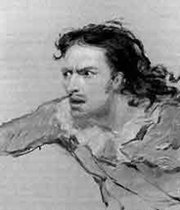
I find Shakespeare fascinating. Shakespeare has been hugely popular on British stages almost non-stop since his own time, and the Regency was a high point for Shakespeare in many ways. Of course, the Regency Shakespeare wasn’t exactly like our Shakespeare….and certainly it wasn’t Shakespeare’s Shakespeare…

Here we have two pictures of the reconstructed Theatre Royal, Covent Garden — where John Philip Kemble produced and starred in many of Shakespeare’s greatest works. Kemble’s sister, Sarah Siddons, was one of the theatre’s biggest draws, and had a following so passionate it was almost religious. (After the theatre pictures, we have two pictures of Kemble, one of Siddons, and one of Kean.)

What fascinates me most are the differences in the Shakespeare plays in the different periods. When I researched my workshop “The Regency Joy of Sex (Drugs & Gaming Hells)” for this year’s Romance Writers of America national conference, I was most intrigued by the changes made to Shakespeare’s text in the period — and the changes that weren’t made. In other words, what parts of Shakespeare they found taboo (or, in Regency parlance, “indelicate”), and which were acceptable for a theatre audience comprising men, women, and children drawn from all classes.

So what was acceptable? When John Philip Kemble edited Shakespeare’s text, here are some words he left in: virgin, adultery, fornicatress, naked, damned incest, bosom, virgin-violator, bastard, deflowered maid. (However, in one passage, “virginity” was changed — implying the word “virginity” was more shocking than “virgin”, which at the time didn’t necessarily have the purely sexual meaning we attach to it.)

So what was taken out? The most common change I found was the invariable changing of the word “body” to the word “person.” It seems the Regency folk didn’t really mind sex, or talk about sex, but some words they found too gross, too vulgar, too indelicate — and “body” was one of them. (Versions of the Bible in this period also took out the word “body” and similar words.)

In one passage, “virginity” becomes “honour.” The word “lechery” becomes “wenching.” One passage from “Measure for Measure” was cut and rearranged thus:
SHAKESPEARE’S ORIGINAL: Why, what a ruthless thing is this in him, for the rebellion of a codpiece to take away the life of a man!
J. P. KEMBLE’S VERSION: Why, what a ruthless thing is this in him, to take away the life of a man for–
Ah, yes, the telling “trailing off” trick. (Too true!)
Is anyone else fascinated by Regency Shakespeare? Any questions? Comments? Favorite plays? Plays you wish you could see the Regency versions of? Or any comments on the topic of bowdlerism in general? (Though the term did not yet exist, and Bowdler was only getting started in our period…)
Cara
Cara King, MY LADY GAMESTER — out now!!!
for more info on Regency theatre, see http://caraking.com/Theatre.html
for more info on Regency private life, see http://caraking.com/PrivateLife.html







